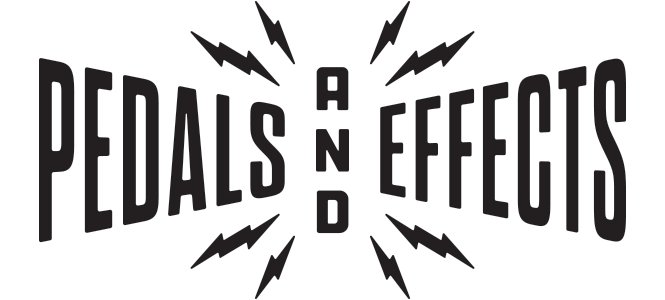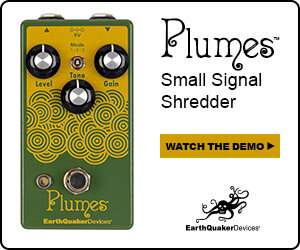Vintage Pedal of the Week: Marshall
/This week’s Vintage Pedal of the Week entry is a story about a music industry behemoth dipping their feet into manufacturing effects pedals. The behemoth in question is Marshall amplification, and for a very brief time they tried their hand at manufacturing a series of amp simulating distortion pedals.
Marshall of course, is known worldwide for their amplifiers which have become synonymous with rock and roll. Back in the 80’s in Los Angeles, anyone and everyone played Marshall amps, Marshall amps were as ubiquitous as hairspray on the Sunset Strip! The sound of Marshall was everywhere and they wanted to turn their classic sound into something portable and affordable for musicians. In 1988 Marshall introduced their first entry into the pedal market, the “Guv’nor” which was meant to replicate the sound of a Marshall head in a pedal. Made in England, the Guv’nor looks and feels like a DI box moreso than a compact effects pedal, with a relatively weighty chassis. The Guv’nor attempted to replicate the tube sound with solid state circuitry, and for that reason you got a sustainable amount of gain with a touch of compression. The Guv’nor also featured an FX loop where the pedal acted as a “master switch” for any pedal plugged into it’s loop, the only problem was that you needed a “Y/Insert” (1/4″ into two mono 1/4″) cable which aren’t as readily available as your standard 1/4″ patch cables. While not as involved or intuitive as a true amp simulator these days, the Guv’nor and subsequent Marshall pedals were more valve distortion emulators at their core than they were true amp modelers.
Enter the 1990’s and Marshall introduces the Drivemaster, the Bluesbreaker and the Shredmaster to complement the Guv’nor distortion as overdrives. The Bluesbreaker was intended to model it’s respective amp counterpart, with the Drivemaster emulating a JCM800 and the Shredmaster being a high gain overdrive named for a certain musical trend at the time. The knobs on each of these pedals reflected Marshall’s classic amp settings with your standard, bass, treble, contour, presence and gain knobs with the gain stages already inherently varying from pedal to pedal. The Bluesbreaker had a lower gain stage than the Drivemaster, with the Shredmaster having the most output.
Unfortunately the Marshall pedals were proprietary to a fault, almost every aspect of the pedal was hardwired/soldered directly onto the circuit board making maintenance tedious and difficult. BOSS, MXR and Ibanez were still very much ahead in the overdrive game, with Marshall’s pedals existing in their shadows. With the success of the JCM800 and JCM900, Marshall continued to push innovation with their amps while the pedals became somewhat of an afterthought. Production of the pedals was then delegated to Korea and Taiwan until they were eventually all but discontinued by 1992.
It wasn’t until a band called Radiohead became really popular in the late 90’s when the Marshall pedals, (specifically the Shredmaster) saw new life in the secondary market. Radiohead guitarist Jonny Greenwood made extensive use of the high gain output of the Shredmaster and once musicians found out he used it, their value skyrocketed. Once available for 30-40 dollars off the shelf, the Shredmaster now goes for 150-200 with the Guv’nor reaching similar price points. Time and time again, all it takes is one person making great use of a pedal for it to suddenly become highly coveted (see: DOD Meatbox).
With Marshall’s legacy cemented in music, Marshall recently decided to re-release the Guv’nor and try their hand once again at compact effects pedals. Their newest line features compression, tremolo, echo, and reissues of the Bluesbreaker and Guv’nor. However these reissues come short of the original ambition of the first generation of their pedals. Considering how prevalent digital amp simulators, and amp modelers are these days, Marshall was way ahead of their time in the creation of these amp-in-a-box pedals. Even Fender would go on to partner up with BOSS and have Fender amp modeling pedals.
Regardless of price or popularity, you should never doubt an effects pedals potential. That 20 dollar bargain bin find might be the core characteristic of your sound, or even make it onto a platinum selling record. Always be curious, always be innovative.
If you think you’ve stumbled onto a one of a kind pedal that no ones heard of, or if there’s a vintage pedal you want to hear more about, email us at juan@pedalsandeffects.com The market is always changing, so that hidden gem or cheap pedal you found in a pawn shop might be worth more than you got it for. Regardless of price it’s all about how much a pedal is worth to you, new, old, cheap, vintage, reissue etc. You can check Reverb, eBay and Craigslist for Marshall pedals. Happy hunting!
Words by Max Kane












